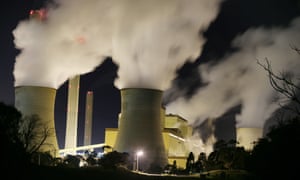Extract from The Guardian
A report by Blueprint Institute says coal-fired power generation is in ’permanent decline’ and its end is ‘inevitable’
A centre-right thinktank with links to former Liberal ministers Robert Hill and Christopher Pyne has said the Morrison government should commit to halving emissions from coal-fired electricity this decade, and the Coalition could drive the change by using some existing policies.
A report from the Blueprint Institute said the latest emissions projections released by the government indicated Australia would not meet its 2030 target. The only way to permanently reduce carbon emissions was to “reduce our economy’s structural reliance on them”.
Coal-fired power generation was now in “permanent decline”, it said, and in 2019, 21% of Australia’s electricity came from renewable sources. Since the last coal plant was commissioned in 2009, wind power had grown by 15% a year, solar by almost 50% a year, “and that pace is accelerating”.
The report, to be released on Monday, said the transformation trend was so baked in it was no longer a question of the government making a decision to end coal-fired generation: “Its end is inevitable, its role in permanent decline.
“All that’s left for the commonwealth to decide is whether it’s willing to step up and coordinate an orderly phase-down that provides certainty for communities, workers, consumers, and investors.”
The Blueprint Institute is a relatively new thinktank drawing staff who have worked for federal Liberal MPs – including Julie Bishop and Dave Sharma – and policy experts. A number of board members have worked in state politics, and the strategic council of the organisation includes Hill, Pyne, former NSW Liberal parliamentarian Michael Photios, and former state and federal minister Bruce Baird.
Its report, “Phasing Down Gracefully”, suggested the government could manage the retirement of coal generation in an orderly fashion – and with fewer job losses than was sometimes claimed in Australia’s hyper-partisan brawling about climate policy – by announcing new sectoral emissions reduction targets for 2026, 2028 and beyond the current medium-term target for 2030.
It said under the Coalition’s existing safeguard mechanism “sectoral emissions caps” could be imposed to drive participation in a new coal-generation phase-down mechanism that would be administered by the clean energy regulator. The safeguard mechanism, which began in 2016, applies to facilities emitting more than 100,000 tonnes of carbon dioxide equivalent a year.
Having set targets, the government could then offer contracts for emissions reductions that would both cap pollution and guarantee a minimum electricity supply until the contract expired.
Generators would participate in a sealed bid auction system. The scheme the thinktank proposed would also contain requirements that generators offer redeployment and retraining opportunities for workers.
The mechanism could either generate revenue that could be distributed in communities impacted by the closures, or alternatively the government could pay out the generators for the profits they would lose because of an early exit from the system – an option that would cost taxpayers billions.
In terms of job losses, the report noted Australia’s coal industry employed 50,000 workers directly and 120,000 workers indirectly.
But it said the coal-fired generation sector employed fewer than 10,000 workers, including the thermal coalminers who supply the generators. It acknowledged the emissions reduction commitment it proposed would see “roughly half these workers lose their jobs”.
But the report said it was entirely possible for Australia to continue to export coal for a time while shutting down coal generation domestically.
“Any suggestion that an Australian commitment to net zero by 2050 or a drive to decarbonise our electricity sector risks the future of our coal industry is simply false,” the report said.
The export market for thermal coal would decline in this decade. It said: “Over 74% of our thermal coal exports go to China, Japan, and South Korea – which have all pledged net-zero.”
But it said metallurgical coal – which is required for steel making – formed most coal exports from Australia. Metallurgical coal would be required for at least the next decade because “we are yet to develop and commercialise zero-emissions alternatives”.
“Notwithstanding their net-zero commitments, robust steel production by our major trading partners is likely to continue to underpin robust demand for our metallurgical coal for some time.
“This will secure the majority of jobs in our coal industry, as well as generating economic activity in local communities and revenues for state governments”.
Australia had time to be part of developing alternatives, and transition was consistent with the Morrison government’s technology investment roadmap.
The Morrison government “should face up to the inevitable” and “take responsibility for what is a national problem, and set out a plan for how our electricity market will evolve this decade and beyond”.
While Scott Morrison’s language on a climate policy pivot has warmed up since Joe Biden was declared the winner of the American presidential contest, the government continues to say it will not sign up to a mid-century emissions reduction target unless it can explain the costs to the public.
Morrison had planned to flag the likelihood that Australia would meet its 2030 target without having to resort to controversial Kyoto-era carryover credits at a climate ambition summit last weekend, but Australia was not granted a speaking slot at an event reserved for significant new commitments.
Australia’s target for 2030 is a cut of 26%-28% on 2005 levels. As the Blueprint Institute report noted, current projections suggest the country is falling short of that objective. On current projections Australia was likely to land at 22% below 2005 levels at the end of the decade.

No comments:
Post a Comment